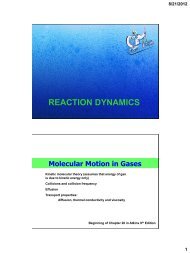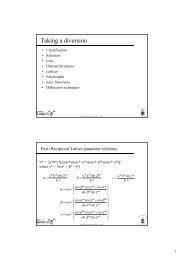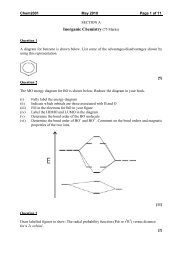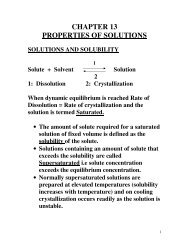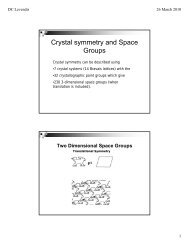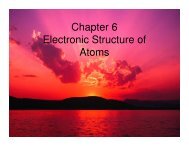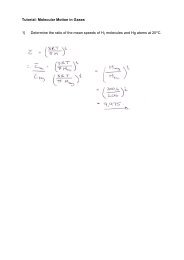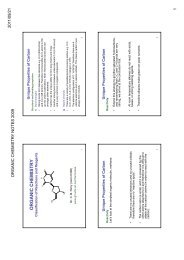ELECTROCHEMISTRY - Wits Structural Chemistry
ELECTROCHEMISTRY - Wits Structural Chemistry
ELECTROCHEMISTRY - Wits Structural Chemistry
You also want an ePaper? Increase the reach of your titles
YUMPU automatically turns print PDFs into web optimized ePapers that Google loves.
4/1/2010<br />
Electrochemistry<br />
Relating electricity and chemical reactions<br />
<strong>ELECTROCHEMISTRY</strong><br />
Transfer of electrons<br />
CHAPTER 20<br />
Chemical reaction<br />
occurs to produce<br />
electricity<br />
Electricity applied<br />
to produce<br />
chemical reaction<br />
Manufacturing<br />
of chemicals<br />
Electroplating<br />
and refining<br />
of metals<br />
Study of redox<br />
reactions<br />
Applications of<br />
Electrochemistry<br />
Bioelectrochemistry:<br />
study of electron<br />
transfer in biological<br />
regulation of<br />
organisms<br />
Batteries<br />
Fuel cells<br />
Study and<br />
control for<br />
corrosion<br />
Recall<br />
Oxidation – LOSS of electrons<br />
Reduction – GAIN of electrons<br />
Oxidation number –<br />
For a monatomic ion the oxidation no. = the<br />
actual charge of the atom<br />
or it is the hypothetical charge assigned to the<br />
atom using a set of rules.<br />
Make sure YOU know how to assign oxidation<br />
numbers!!!!<br />
Oxidation occurs at the ANODE<br />
Reduction occurs at the CATHODE<br />
Oxidising agent/oxidant – The substance that<br />
causes oxidation of another substance and<br />
hence it is reduced.<br />
Reducing agent/reductant – The substance that<br />
cause reduction of another substance and<br />
hence it is oxidised.<br />
ELECTRIC CURRENT = transfer of charge<br />
METALLIC CONDUCTION = flow of electrons<br />
with no movement of the atoms of the metal<br />
ELECTROLYTIC (IONIC) CONDUCTION =<br />
electric current by movement of ions through a<br />
solution or pure liquid<br />
How do we know if a chemical<br />
reaction is a REDOX reaction<br />
Look to see if there is a change in oxidation<br />
numbers of elements.<br />
Zn(s) + 2H + (aq) Zn 2+ (aq) + H 2 (g)<br />
0 +1 +2 0<br />
Both oxidation and reduction must occur.<br />
Electrons lost by one component is gained<br />
by another.<br />
1
4/1/2010<br />
Oxidation Number Guidelines<br />
1. Atoms in elemental form, oxidation number is zero.<br />
(Cl 2 , H 2 , P 4 , Ne are all zero)<br />
2. Monoatomic ion, the oxidation number is the charge on<br />
the ion. (Na + : +1; Al 3+ : +3; Cl - : -1)<br />
3. O is usually -2. But in peroxides (like H 2 O 2 and Na 2 O 2 ) it<br />
has an oxidation number of -1.<br />
4. H is +1 when bonded to nonmetals and -1 when bonded<br />
to metals.<br />
(+1 in H 2 O, NH 3 and CH 4 ; -1 in NaH, CaH 2 and AlH 3 )<br />
5. The oxidation number of F is -1.<br />
6. The sum of the oxidation numbers for the molecule is the<br />
charge on the molecule (zero for a neutral molecule).<br />
Example:<br />
A nickel–cadmium battery (NiCad) is a<br />
rechargeable “dry cell” that uses the following<br />
redox reaction to generate electricity:<br />
Cd(s) + NiO 2 (s) +2H 2 O(l) Cd(OH) 2 (s) + Ni(OH) 2 (s)<br />
Identify the substances oxidised & reduced and<br />
the oxidising & reducing agents.<br />
Balancing Redox Reactions<br />
In acidic solutions:<br />
1. Write the 2 half-reactions<br />
2. Balance elements other than O and H<br />
3. Balance O by adding H 2 O<br />
4. Balance H by adding H +<br />
5. Balance electrons<br />
6. Multiply half-reactions by integer so that no.<br />
of electrons in both are equal<br />
7. Add the 2 half-reactions<br />
EXAMPLE:<br />
Mn 2+ (aq) + NaBiO 3 (s) Bi 3+ (aq) + MnO 4- (aq)<br />
1. Write the 2 half-reactions<br />
2. Balance elements other than O and H<br />
3. Balance O by adding H 2 O<br />
4. Balance H by adding H +<br />
5. Balance electrons<br />
6. Multiply half-reactions by integer so that no. of<br />
electrons in both are equal<br />
7. Add the 2 half-reactions<br />
In basic solutions:<br />
1. Write the 2 half-reactions<br />
2. Balance elements other than O and H<br />
3. Balance O by adding H 2 O<br />
4. Balance H by adding H +<br />
5. Add an equal number of OH - to both sides of<br />
the reaction so that all H + is “neutralised”<br />
Recall: H + + OH - H 2 O<br />
6. Balance electrons<br />
7. Multiply half-reactions by integer so that no.<br />
of electrons in both are equal<br />
8. Add the 2 half-reactions<br />
2
4/1/2010<br />
EXAMPLE:<br />
Mn 2+ (aq) + NaBiO 3 (s) Bi 3+ + MnO 4- (aq)<br />
1-4. Same as before<br />
5. Add an equal number of OH - to both sides of the<br />
reaction so that all H + is “neutralised”<br />
For you to do!<br />
Balance the following:<br />
MnO 4- (aq) + C 2 O<br />
2-<br />
4 (aq) Mn 2+ (aq) + CO 2 (g)<br />
Answers:<br />
6-8. Same as before<br />
Voltaic/Galvanic Cells<br />
A spontaneous redox reaction produces energy<br />
which can do electrical work.<br />
Example:<br />
Zn(s) + Cu 2+ (aq) Zn 2+ (aq) + Cu(s)<br />
Spontaneous reaction!<br />
Half-reactions:<br />
Zn(s) Zn 2+ (aq) + 2e -<br />
Cu 2+ (aq) + 2e - Cu(s)<br />
Electrons lost by Zn are gained by Cu 2+ .<br />
Zn strip inserted into<br />
CuSO 4 solution<br />
Zn(s) Zn 2+ (aq) + 2e -<br />
Cu 2+ (aq) + 2e - Cu(s)<br />
Molecular view:<br />
In a galvanic/voltaic cell – the transfer of<br />
electrons takes place through an external<br />
circuit rather than directly between reactants.<br />
Cu 2+ ion must collide with<br />
the Zn strip for electron<br />
transfer to occur.<br />
The Zn 2+ ion formed<br />
enters the solution and<br />
the Cu o is deposited on<br />
the Zn strip.<br />
Reaction at cathode =<br />
Reaction at anode =<br />
Zn(s) Zn 2+ (aq) + 2e - Cu 2+ (aq) + 2e - Cu(s)<br />
Oxidation:<br />
Reduction:<br />
3
4/1/2010<br />
Reaction at cathode =<br />
Reaction at anode =<br />
Zn(s) Zn 2+ (aq) + 2e - Cu2+(aq) + 2e- Cu(s)<br />
Oxidation:<br />
Reduction:<br />
Salt bridge:<br />
‣ Completes the circuit.<br />
‣ Maintains electrical neutrality in the two<br />
compartments by migration of ions<br />
through the porous material.<br />
‣ No further redox reaction will take place if<br />
electrical neutrality is not maintained.<br />
‣Prevents mixing of the electrode solutions.<br />
Molecular view:<br />
2<br />
The 2e - ’s move through the circuit to the Cu strip.<br />
Cell Notation:<br />
Oxidation at anode<br />
Reduction at cathode<br />
Separate<br />
phases<br />
electrode in soln<br />
Salt<br />
bridge<br />
Separate<br />
phases<br />
in soln electrode<br />
Zn(s) Zn 2+ (1 M) Cu 2+ (1 M) Cu(s)<br />
1<br />
On the Zn strip, a Zn atom<br />
“looses” 2e - ’s to form Zn 2+<br />
which moves into solution.<br />
When the Cu 2+ ions collide with<br />
the Cu strip, 2e - ’s are<br />
transferred to form Cu o<br />
3<br />
Cell EMF<br />
E cell depends on:<br />
Why do electrons flow in the direction they do<br />
Due to the potential difference between the 2<br />
electrodes (or difference in potential energy)<br />
Electrons at the anode have a higher potential<br />
energy than the electrons at the cathode<br />
electrons spontaneously flow from<br />
anode to cathode<br />
The potential difference is the driving force that<br />
pushes electrons through the circuit<br />
= electromotive force = EMF<br />
= cell voltage<br />
= cell potential = E cell<br />
• the reactions that occur at the electrodes<br />
• the concentrations of reactants and products<br />
• temperature (assume 25 o C unless otherwise stated)<br />
E cell > 0 for a SPONTANEOUS cell reaction!<br />
By convention<br />
E o cell = standard cell potential<br />
Standard conditions:<br />
1 M concentration for reactants & products<br />
1 atm pressure for gases<br />
Zn(s) + Cu 2+ (aq,1M) Zn 2+ (aq,1M) + Cu(s)<br />
E o cell = +1.10 V<br />
4
4/1/2010<br />
Standard Reduction Potentials<br />
Standard hydrogen electrode (SHE)<br />
Recall: the cell potential is the difference<br />
between 2 electrode potentials (the anode and<br />
the cathode)<br />
E o cell = E o red(cathode) - E o red(anode)<br />
Table of Standard Reduction Potentials <br />
Potentials all measured relative to the<br />
standard hydrogen electrode (SHE)<br />
2H + (aq, 1M) + 2e - H 2 (g, 1atm)<br />
E o = 0 V<br />
2H + (aq, 1M) + 2e - H 2 (g, 1atm)<br />
H 2 (g, 1atm) 2H + (aq, 1M) + 2e-<br />
E o (Cath) = 0 V<br />
E o (An) = 0 V<br />
Standard Reduction Potentials in H 2 O at 25 o C<br />
The more positive the value for E o red, the<br />
stronger the driving force for reduction.<br />
Note:<br />
Since electrical potential measures potential<br />
energy per electrical charge, the standard<br />
reduction potential is a intensive property.<br />
1 V = 1 J 1 C<br />
changing a stoichiometric coefficient in a<br />
half-reaction does NOT affect the value of the<br />
standard reduction potential.<br />
Zn 2+ (aq, 1M) + 2e - Zn(s)<br />
2Zn 2+ (aq, 1M) + 4e - 2Zn(s)<br />
E o = -0.76 V<br />
E o = -0.76 V<br />
Example:<br />
List according to increasing strength of<br />
reducing agent:<br />
Ag(s), Zn(s), Cu(s)<br />
Which is the weakest oxidising agent:<br />
Ag + , Zn 2+ , Cu 2+ <br />
5
4/1/2010<br />
Spontaneity of Redox Reactions<br />
So far we know:<br />
E o cell = E o red(cathode) - E o red(anode)<br />
AND<br />
From the standard reduction potentials table:<br />
E o red(cathode) > E o red(anode)<br />
for a spontaneous reaction<br />
THEREFORE<br />
E o cell > 0 for a SPONTANEOUS cell reaction!<br />
We also know that:<br />
G < 0 spontaneous reaction<br />
Relationship between EMF and free energy<br />
change:<br />
G = -nFE<br />
where n = no. of e - ’s transferred<br />
F = Faraday’s constant<br />
= 96 500 C mol -1 96 500 J V -1 mol -1<br />
For reactants and products in their standard<br />
state:<br />
G o = -nFE o<br />
Example:<br />
Use standard reduction potentials to calculate standard<br />
free energy change for the following reaction:<br />
4Ag(s) + O 2 (g) + 4H + (aq) 4Ag + (aq) + 2H 2 O(l)<br />
From the table:<br />
Reduction:<br />
O 2 (g) + 4H + (aq) + 4e - 2H 2 O(l)<br />
Oxidation:<br />
Ag + (aq) + e - Ag(s)<br />
E o = 1.23 V<br />
E o = 0.80 V<br />
Also: 4Ag + (aq) + 4e - 4Ag(s) E o = 0.80 V<br />
Repeat for:<br />
2Ag(s) + 1 / 2 O 2 (g) + 2H + (aq) 2Ag + (aq) + H 2 O(l)<br />
Ans:<br />
Recall:<br />
G<br />
G<br />
Effect of concentration<br />
o <br />
Since G o = -nFE o<br />
E E<br />
E E<br />
E E<br />
o <br />
o <br />
o <br />
RTlnQ<br />
RT<br />
lnQ<br />
nF<br />
and G = -nFE<br />
2.303RT<br />
logQ<br />
nF<br />
0.05916<br />
logQ<br />
n<br />
Nernst equation<br />
at 25 o C<br />
R=8.315 J K -1 mol -1<br />
F=96500 J V -1 mol -1<br />
T = 298 K<br />
E E<br />
o <br />
Use the Nernst equation to:<br />
0.05916<br />
logQ<br />
n<br />
- find the EMF produced by a cell under nonstandard<br />
conditions.<br />
- determine the concentration of reactant or<br />
product by measuring the EMF of the cell.<br />
6
4/1/2010<br />
Example:<br />
Consider the reaction:<br />
Zn(s) + Cu 2+ (aq) Zn 2+ (aq) + Cu(s)<br />
Calculate the cell emf when:<br />
[Cu 2+ ] = 5.0 M and [Zn 2+ ] = 0.5 M<br />
Since emf depends on concentration, a voltaic cell with<br />
a non-zero emf can exist using the same species in both<br />
the anode and cathode compartments.<br />
CONCENTRATION CELL<br />
Anode: Ni(s) Ni 2+ (aq) + 2e - E o red = -0.28V<br />
Cathode: Ni 2+ (aq) + 2e - Ni(s) E o red = -0.28V<br />
E o cell = E o red(cathode) - E o red(anode)<br />
= (-0.28 V) – (-0.28 V) = 0V<br />
But the cell is operating under non-standard conditions<br />
since concentrations are 1 M.<br />
Driving force of cell due to the difference in<br />
concentration tries to equalise<br />
concentrations in both compartments.<br />
Anode: Ni(s) Ni 2+ (aq, dil) + 2e -<br />
Cathode:<br />
Ni 2+ (aq, conc) + 2e - Ni(s)<br />
Ni 2+ (aq, conc) Ni 2+ (aq, dil)<br />
Anode: Ni(s) Ni 2+ (aq, dil) + 2e -<br />
Cathode:<br />
o 0.05916 [Ni<br />
E E log<br />
n [Ni<br />
]<br />
2<br />
dil<br />
2<br />
]<br />
conc<br />
0.05916 (1.00<br />
10<br />
E (0V) log<br />
2 (1.00)<br />
E 0.0887 V<br />
NOTE:<br />
Ni 2+ (aq, conc) + 2e - Ni(s)<br />
Ni 2+ (aq, conc) Ni 2+ (aq, dil)<br />
When the concentrations in the 2 compartments<br />
become equal,<br />
Q = 1 and E = 0 V.<br />
3<br />
)<br />
EMF and Equilibrium<br />
Why does the emf drop as a voltaic cell<br />
discharges<br />
0.05916<br />
Look at Nernst equation: E E<br />
o logQ<br />
n<br />
As reactants are converted to products, Q<br />
increases.<br />
Eventually E = 0 V.<br />
Since G = -nFE, G = 0 kJ/mol<br />
equilibrium!<br />
i.e. when E = 0 V, equilibrium<br />
no net reaction<br />
The equilibrium constant can be calculated for<br />
a redox reaction as follows:<br />
At equilibrium:<br />
E = 0 V and Q = K<br />
E E<br />
0 E<br />
o <br />
o <br />
0.05916<br />
logQ<br />
n<br />
0.05916<br />
logK<br />
n<br />
o<br />
nE<br />
logK<br />
<br />
0.05916<br />
7
4/1/2010<br />
Nernst equation<br />
E E<br />
o <br />
RT<br />
lnQ<br />
nF<br />
BATTERIES<br />
A battery is a portable , self contained<br />
electrochemical power source that consist of<br />
one or more voltaic cells.<br />
The Nobel Prize in <strong>Chemistry</strong> 1920<br />
Nobel Lecture, December 12, 1921<br />
Studies in Chemical Thermodynamics<br />
Greater voltages can be achieved if cells are<br />
placed in series e.g. in a torch.<br />
Cathode = “+” Anode = “-”<br />
Walther Hermann Nernst<br />
(1864 - 1941)<br />
German physicist and chemist<br />
Separate anode and cathode compartments<br />
with a porous barrier<br />
Cell emf depends on the substances that are<br />
oxidised and reduced.<br />
Cell life depends on the quantities of the<br />
substances.<br />
Primary cell – cannot be recharged<br />
Secondary cell – can be recharged<br />
Lead-acid battery<br />
Used in cars<br />
12 V = 6 x 2 V cells<br />
Anode = Pb<br />
Cathode = PbO 2 packed on metal grid<br />
Electrolyte = H 2 SO 4<br />
Spacers prevent cathode and anode from touching.<br />
Cathode: PbO 2 + 4H + + SO<br />
2-<br />
4 + 2e - PbSO 4 + 2H 2 O<br />
Anode: Pb + SO<br />
2-<br />
4 PbSO 4 + 2e-<br />
Overall: PbO 2 + Pb + 4H + + 2SO<br />
2-<br />
4 2PbSO 4 + 2H 2 O<br />
E o cell = (+1.685)-(-0.356) = +2.041 V<br />
Solid products and reactants<br />
not appear in expression for Q<br />
maintain relatively constant emf while discharging<br />
variation due to [H 2 SO 4 ] decreases during discharge<br />
Can be recharged since PbSO 4 adheres to the electrode<br />
surface.<br />
External source of power = alternator (generator) driven<br />
by the engine.<br />
8
4/1/2010<br />
Alkaline battery<br />
Most common primary battery<br />
Anode = Zn powder immobilised in gel surrounded by<br />
electrolyte<br />
Cathode = MnO 2 + graphite<br />
Electrolyte = conc. solution of KOH<br />
Separator = porous fabric<br />
Cathode: 2MnO 2 +2H 2 O + 2e - 2MnO(OH) + 2OH -<br />
Anode: Zn + 2OH - Zn(OH) 2 + 2e-<br />
Overall: 2MnO 2 + Zn + 2H 2 O 2MnO(OH) + Zn(OH) 2<br />
E o cell = +1.55 V<br />
Dry cell or Zinc carbon battery<br />
Cathode: 2MnO 2 + NH 4+ + 2e - Mn 2 O 3 + NH 3 +<br />
Anode: Zn Zn 2+ + 2e-<br />
Overall: 2MnO 2 + Zn + NH 4+ Mn 2 O 3 + Zn 2+ +NH 3 + H 2 O<br />
E o cell = +1.55 V<br />
Nickel-cadmium, Nickel-metalhydride<br />
and Lithium-ion batteries<br />
Used in high-power-demand portable devices<br />
e.g. cellphones, PC’s etc<br />
Lightweight and readily rechargeable<br />
Alkaline batteries better performance than the old dry<br />
cells which are also based on MnO 2 and Zn .<br />
NiCad batteries:<br />
Cathode: 2NiO(OH) + 2H 2 O + 2e - 2Ni(OH) 2 + 2OH -<br />
Anode: Cd + 2OH - Cd(OH) 2 + 2e -<br />
Overall: 2NiO(OH) + Cd + 2H 2 O 2Ni(OH) 2 + Cd(OH) 2<br />
NiMH batteries:<br />
Same cathode reaction as in NiCad batteries.<br />
Anode reaction different.<br />
E o cell = = 1.30 V <br />
use cells in series<br />
Anode = metal alloy (eg ZrNi 2 ) that has the ability to<br />
absorb hydrogen atoms<br />
-Solid adheres to electrodes rechargeable<br />
-Disadvantage:<br />
Cd = toxic heavy metal<br />
increases mass of battery<br />
+ environmental hazard<br />
During oxidation process H-atoms are released<br />
9
4/1/2010<br />
Li-ion batteries:<br />
Advantages:<br />
- Li has the most negative standard reduction potential,<br />
thus makes a good anode.<br />
- Li is a lightweight metal.<br />
- Cell emf can be as high a 3 V.<br />
Solid electrolyte used.<br />
Based on ability of Li + ions to insert themselves into<br />
certain layers solids.<br />
Disadvantages:<br />
- Batteries do not yet have high reliability and long<br />
lifetime<br />
Fuel cells<br />
Thermal energy released during combustion of<br />
fuels is converted to electrical energy.<br />
This process is only about 40% efficient.<br />
Because combustion reactions are redox<br />
reactions, the process can be carried out<br />
electrochemically<br />
found efficiency is almost doubled<br />
Unlike batteries, fuel cells do not store chemical<br />
energy. Reactants must be constantly supplied<br />
and products removed from the fuel cell.<br />
Example: The hydrogen fuel cell<br />
Cathode: O 2 + 2H 2 O + 4e - 4OH -<br />
Anode: 2H 2 + 4OH - 4H 2 O + 4e-<br />
Overall:<br />
2H 2 + O 2 2H 2 O<br />
2H 2 + O 2 2H 2 O<br />
CORROSION<br />
The deterioration of metals by an<br />
electrochemical process.<br />
10
4/1/2010<br />
Examples of corrosion:<br />
- rust on iron<br />
- tarnish on silver<br />
- green patina on copper and brass<br />
For almost all metals oxidation is a<br />
thermodynamically favourable process at room<br />
temperature.<br />
Can be extremely destructive<br />
or can form a protective oxide layer.<br />
Oxidation of Aluminium<br />
Expect Al to be readily oxidised<br />
Al 3+ + 3e - Al<br />
E o = -1.66 V<br />
However, we find it is exceptionally stable in air.<br />
WHY<br />
A thin protective layer of a hydrated form of<br />
Al 2 O 3 forms on the surface of the metal.<br />
This oxide layer is then impermeable to O 2 and<br />
H 2 O, thus protecting the underlying metal from<br />
further corrosion.<br />
Corrosion of Iron<br />
Rusting<br />
Need both O 2 and H 2 O.<br />
Cathode: O 2 (g) + 4H + (aq) + 4e - 2H 2 O(l) E o red = 1.23 V<br />
Anode: Fe(s) Fe 2+ (aq) + 4e- E o red = -0.44 V<br />
Fe + O 2 + 4H + Fe 2+ + 2H 2 O<br />
Need H + for corrosion<br />
above pH 9 Fe does not corrode<br />
Cathode:<br />
O 2 (g) + 4H + (aq) + 4e - 2H 2 O(l)<br />
Anode: Fe(s) Fe 2+ (aq) + 4e-<br />
Fe + O 2 + 4H + Fe 2+ + 2H 2 O<br />
Further oxidation of Fe 2+ to Fe 3+ :<br />
4Fe 2+ + O 2 + (4+2x)H 2 O 2Fe 2 O 3 .xH 2 O + 8H +<br />
Rust<br />
Part of the Fe surface is the anode at which<br />
oxidation occurs.<br />
e - ’s migrate through the Fe metal to another<br />
part of the Fe surface, the cathode, where O 2 is<br />
reduced.<br />
Other factors can accelerate rusting:<br />
- pH of the soln<br />
(lower pH faster corrosion)<br />
- presence of salts<br />
(improves conductivity of electrolyte)<br />
- contact with metals more difficult to oxidise<br />
than Fe<br />
- stress on Fe<br />
11
4/1/2010<br />
Preventing the corrosion of iron<br />
Covering of iron with e.g. paint or tin<br />
- Prevents O 2 and H 2 O from reaching surface.<br />
Galvanised iron coated with layer of zinc<br />
- Protects Fe by electrochemical means even<br />
after coating is damaged<br />
Easier to oxidise Zn (anode) than Fe (cathode)<br />
Zn rather corrodes<br />
- Coating damaged corrosion<br />
Cathodic protection<br />
Zn = sacrificial anode<br />
E o red/V<br />
Reduction Half-reaction<br />
+0.77 Fe 3+ (aq) + e - Fe 2+ (aq)<br />
Cathodic protection is used for e.g. the<br />
protection of iron pipelines or storage tanks<br />
-0.44 Fe 2+ (aq) + 2e - Fe(s)<br />
-0.76 Zn 2+ (aq) + 2e - Zn(s)<br />
-2.36 Mg 2+ (aq) + 2e - Mg(s)<br />
Mg is the sacrificial anode for the Fe tank.<br />
ELECTROLYSIS<br />
Electrolysis of molten NaCl<br />
Use electrical energy to<br />
cause non-spontaneous<br />
redox reaction to occur<br />
- Takes place in electrolytic<br />
cells<br />
- Need an external DC source<br />
e.g. a battery<br />
= electron pump<br />
Reduction occurs at the<br />
cathode (negative) and<br />
oxidation occurs at the<br />
anode (positive)<br />
12
4/1/2010<br />
Electrolysis of aqueous solutions<br />
Example: Electrolysis of aqueous NaF solution<br />
Need high temp’s to produce molten salts.<br />
Can also produce ions by dissolving salts in<br />
water at room temp.<br />
2 possible cathode reactions:<br />
Na + (aq) + e - Na(s)<br />
2H 2 O(l) + 2e - H 2 (g) + 2OH - (aq)<br />
E o red = -2.71 V<br />
E o red = -0.83 V<br />
Problem:<br />
Electrolysis of aqueous salts complicated<br />
by the presence of water.<br />
Favoured reduction reaction<br />
more +ve or less –ve E o red<br />
Cathode:<br />
2H 2 O(l) + 2e - H 2 (g) + 2OH - (aq)<br />
2 possible anode reactions:<br />
2F - (aq) F 2 (g) + 2e -<br />
2H 2 O(l) O 2 (g) + 4H + (aq) + 4e -<br />
Favoured oxidation reaction<br />
more -ve or less +ve E o red<br />
2H 2 O(l) O 2 (g) + 4H + (aq) + 4e -<br />
E o red = +2.78 V<br />
E o red = +1.23 V<br />
In fact it is easier still to oxidise OH - (aq) that is<br />
produced at the cathode:<br />
Anode: 4OH - (aq) O 2 (g) + 2H 2 O(l) + 4e -<br />
E o red = +0.40 V<br />
Example: Electrolysis of aqueous NaCl solution<br />
Cathode reactions as in previous example.<br />
2 possible anode reactions:<br />
2Cl - (aq) Cl 2 (g) + 2e -<br />
2H 2 O(l) O 2 (g) + 4H + (aq) + 4e -<br />
Expect favoured reaction to be:<br />
2H 2 O(l) O 2 (g) + 4H + (aq) + 4e -<br />
E o red = +1.36 V<br />
E o red = +1.23 V<br />
Thermodynamics<br />
HOWEVER, in experiments Cl - is oxidised.<br />
Due to kinetics of electrode process!<br />
Activation energy is lower for Cl - oxidation, so it<br />
is kinetically favoured.<br />
Electrolysis with active electrodes<br />
Example: Ni electroplating<br />
Inert electrodes do not undergo reaction but<br />
only act as a surface where oxidation and<br />
reduction occurs.<br />
Active electrodes participate in the<br />
electrolysis process<br />
E.g. electroplating<br />
Find the favoured reaction to be:<br />
Cathode (steel strip):<br />
Ni 2+ (aq) + 2e - Ni(s)<br />
Anode (nickel strip):<br />
Ni(s) Ni 2+ (aq) + 2e -<br />
Pic of<br />
cell<br />
Overall reaction: “transferring Ni atoms” from<br />
the anode to form a thin layer on the steel<br />
cathode.<br />
13
4/1/2010<br />
Quantitative aspects of electrolysis<br />
The stoichiometry of a half-reaction shows us<br />
how many electrons needed in electrolysis.<br />
E.g.<br />
Na + + e - Na<br />
1 mol e - ’s will plate out 1 mol Na metal<br />
Or 2 mol e-’s will plate out 2 mol Na metal<br />
E.g.<br />
Ni 2+ + 2e - Ni<br />
2 mol e-’s will plate out 1 mol Ni metal<br />
Recall:<br />
FARADAY`S LAW<br />
The amount of substance that undergoes<br />
oxidation or reduction at each electrode is<br />
directly proportional to the amount of electricity<br />
that passes through the cell.<br />
Unit of charge (Q) = coulomb (C)<br />
The charge in 1 mole of electrons = 96 500 C<br />
Faraday’s constant, F = 96 500 C/mol<br />
Q = It (Current in A, time in s)<br />
Example:<br />
Calculate the mass of aluminium produced in 1.0 hour<br />
by the electrolysis of molten AlCl 3 if the electrical<br />
current is 20 A.<br />
Where does the Al come from<br />
Al 3+ + 3e - Al<br />
1 Calculate the amount of charge transferred:<br />
Q = It = (20 A)(3600s) = 7.2 x 10 4 C<br />
2 Calculate the no. of moles of e - ’s transferred: Q=nF<br />
7.2 x 10 4 C<br />
Moles of e - ’s =<br />
= 0.75 mol<br />
96 500 C/mol<br />
3 Relate no. of moles of e - ’s to no. of moles of Al formed:<br />
3 mol e - 1 mol Al<br />
0.75 mol e - 0.25 mol Al<br />
4 Convert moles to grams:<br />
m = nM = (0.25 mol)(27.0 g/mol) = 6.7 g Al<br />
Recall:<br />
Electrical work<br />
G < 0 and E cell > 0 spontaneous process<br />
G = -nFE<br />
G = w max<br />
Thus the maximum useful work obtainable from<br />
a voltaic cell is:<br />
w max = -nFE<br />
For an electrolytic cell, work has to be done on<br />
the system for the reaction to occur,<br />
w = nFE ext<br />
where E ext = external potential applied.<br />
Example:<br />
Calculate the number of kWh of electricity required to<br />
produce 1.0x10 3 kg of aluminium by electrolysis of Al 3+<br />
if the applied emf is 4.50 V.<br />
Electrical power is the rate of energy<br />
expenditure.<br />
Unit: Watt (W) = J/s<br />
1 kWh = 3.6x10 6 J<br />
14



